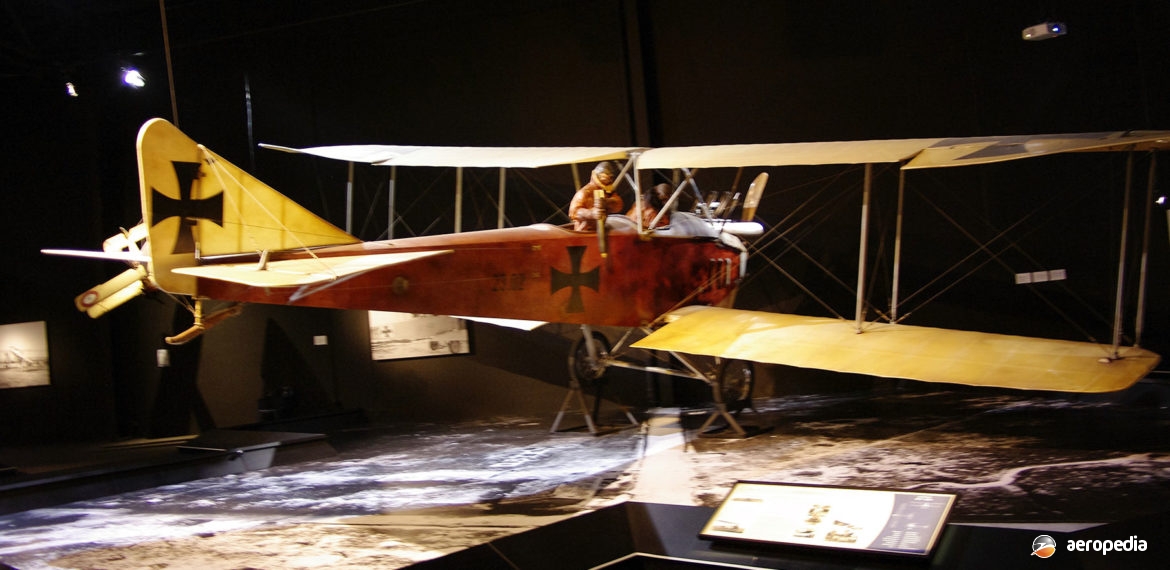Photograph:
Albatros B.II replica (ex D-EKGH) at the Omaka Aviation Heritage Centre, NZ (David C Eyre)
Country of origin:
Germany
Description:
Two-seat reconnaissance biplane
Power Plant:
One 75 kw (100 hp) Mercedes D.1 six-cylinder in-line liquid-cooled engine
Specifications:
- Wingspan: 12.8 m (42 ft)
- Length: 7.63 m (25 ft 0⅜ in)
- Height: 3.15 m (10 ft 4 in)
- Wing area: 40.12 m² (431.8 sq ft)
- Max speed at sea level: 105 km/h (65 mph)
- Service ceiling: 3,000 m (9,845 ft)
- Endurance: 4 hrs
- Loaded weight: 1,071 kg (2,361 lb)
Armament:
Nil
History:
In its early years Albatros-Werke GmbH at its facility at Johannisthal near Berlin, Germany built aircraft under licence from other manufacturers. Amongst these were the Antoinette and the Etrich Taube. In the years 1912 and 1913 at the Berlin Air Exhibitions it displayed two monoplanes of its own design with enclosed cabins and it went on to develop a successful range of aircraft. These designs were the fore-runners of fighter aircraft built for the military services. A number of design features from these aircraft were later used to some success in fighters.
On 28 September 1913 an Albatros flown by Josef Sablatnig carried three passengers to an altitude of 2,830 m (9,282 ft) over the Company’s facility. On 27-28 June 1914 one of the Company’s aircraft stayed aloft for a record 21 hrs 50 mins, covering 1,931 km (1,200 miles), this record being broken two weeks later when Reinhold Bohm in the same aircraft with 600 litres of fuel (132 Imp gals) remained in the air for 24 hrs 12 mins to complete the first non-stop flight of more than 14 hours over a closed circuit.
Albatros-Werke commenced to produce un-armed two-seat biplanes to serve the German Army in the reconnaissance role at the outbreak of hostilities in 1914. The first to enter service was the B.1, which was allocated to Feld Flieger Abteilung units (reconnaissance). It appeared in a number of models and there were variations in the wings being produced in one, two and three-bay wing models. It could be fitted with either a 75 kw (100 hp) Mercedes D.I engine or a 90 kw (120 hp) Mercedes D.II engine. The radiator was mounted above the cylinder block and the pilot sat in the rear cockpit with the observer in the front. Although no defensive armament was installed, the observer regularly carried a rifle or carbine.
The Albatros B.1 was also built by Phonix in Austro-Hungary, and in late 1914 an example achieved an altitude of 4,500 m (14,764 ft). Eventually the two-bay biplane became known as the B.1, and the shorter span wing model known as the B.II, was fitted with a Mercedes D.I engine. The latter model was widely used on reconnaissance and observation work during 1914 and much effort was put into mass producing the type, with the factories of BFW, LFG, Linke-Hofman, Merkur, Kondon and Refla producing aircraft in Germany, as well as Osdeutsche Albatros-Werke in Austria. After the war a number were supplied to Sweden. Late production models became known as the B.IIa, having a strengthened airframe and the Mercedes D.II engine, although a number had the Argus As.II unit.
Flown by nearly all German aces of the time, the Albatros became known as a “graceful fighting scout” and achieved an ascendancy over the Allies that was unknown since the Fokker Scourge. From its introduction in September 1916 it was dominant in both quality and quantity in German Jagdstaffeln. It was designed by the chief designer of Albatros-Werke, Robert Thelen, assisted by Messrs Schubert and Gnaedig, and was based upon a racing version of an Albatros biplane of 1914 which had been built for a competition in Vienna, Austria. It had a carefully streamlined fuselage of wooden semi-monocoque construction and used the most powerful engines available at the time, the 112 kw (150 hp) Benz or the 119 kw (160 hp) Mercedes.
Examples built in Austria by the German subsidiary in Vienna incorporated a slight sweepback of the wings and were usually fitted with an Austrian-built engine. These variants were known as the Series 21, 23 and 24. Some had the 108 kw (145 hp) Hiero engine, and others had a 90 kw (120 hp) Mercedes engine. Many had a Schwarzlose machine gun for the observer. Austrian-built aircraft saw service in the Balkans, Galicia and Italy.
The final variant of the B series was the B.III which was available to units in 1915 for reconnaissance work and was supplied to both the German Army and Navy. This model had short span wings and the strengthened fuselage of the B.II but had a new high aspect ratio vertical tail and a curved tailplane. By late 1915 the B series had become obsolete and was being replaced by the C series.
One Austrian-built machine survives in the Heeresgeschichtliches Museum in Vienna. An airworthy replica B.II was operated by the Historische Flugzeugbau at Furstenwalde in the State of Brandenburg in Germany. In early 2006 another replica of an Albatros B.II, which was completed at Furstenwalde as c/n 01 and first flown in Germany on 22 August 2001 as D-EKGH, joined the collection of World War I aircraft collection at the Omaka Aviation Heritage Centre near Blenheim, NZ.

